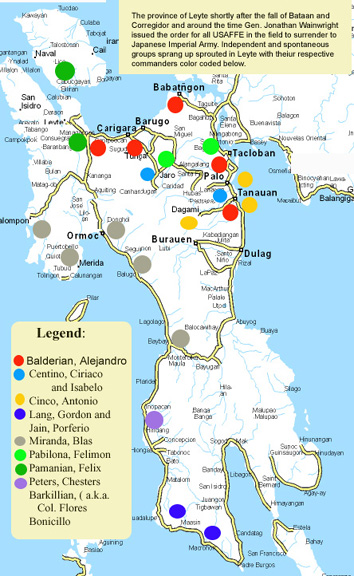
This paper was presented at the Leyte Normal University Regional Workshop-Conference on Social Research last October 17, 2007 by the author, Emil B. Justimbaste. This is just a prelude to a book he is presently writing on the same subject.
Introduction
The Tragedy of Dulag
Northern Leyte Guerillas
Southern Leyte Guerillas
Miranda
Enter Kandleon
MacArthur Connection
Miranda vs. Kangleon
References
Southern Leyte guerillas
Urbano Francisco established his group as early as June 9, 1942, less than a month after the surrender of Leyte's commanding officer Theodore Cornell. Together with Lt. Enrique Carson, he gathered the unsurrendered members of the 3rd Leyte PC Company for an organizational meeting at Barrio Maslog, Malitbog. This was the lanching pad of his guerilla activities in the area. Fifty-three attended that meeting, the majority of whom were PC soldiers and escaped Philippine Army fighters from Bataan.19
In their early days, the group pillaged villagers for their food and other needs There were fewer Japanese in these areas than the towns in the east coast, which meant they had more time to do some mischief. The group once commandeered a passenger truck owned by businessman Joaquin Aberastori which they used to haul their goods, the very same vehicle that they used in their Inopacan encounter with fellow guerilla Chester Peters.20
The Francisco group took an initial shot against the Japanese invaders by executing their chief spy, Gelacio Andrade, in an ambush. Francisco, Carson and four other riflemen easily overpowered Andrade and his four companions and killed them. The action triggered Japanese punitive measures, going after unarmed civilians in their effort to locate the guerillas. A few were arrested and tortured by the Japanese Kempei Tai or military police.21
The Nuique Group was formed by Capt Sergio Nuique, then hiding in the mountains of Sogod, Southern Leyte. He was initiatially joined by American Navy service man Gordon Lang. On Aug 13, 1942, Lang led a platoon of Nuique's group against a Japanese patrol on board a truck in the vicinity of Divisoria, Sogod. Thirteen Japanese were killed, including an officer. Nuique's continued operations in the area caused the Japanese to abandon their garrison in Malitbog in October that year.
Lang-Jain Group. Gordon Lang could not stay long with Nuique and soon made his way to Maasin with a small band. For a while, he exerted his influence in the areas around Maasin, until the arrival of Capt. Porferio Jain who took over the group by virtue of his superior rank. Jain was an army cadre in Catarman, Samar before the surrender of Cornell.
In the meantime, Lt. Jose Nazareno also left the group of Nuique to establish his center of operations in Panaon island. The former USAFFE would soon establish his reputation with his harassment operations against Japanese sea-faring ferries passing the narrow strait between Leyte and Panaon, an activity which Jain would later take part in. With the ascendancy of Kangleon in 1943, the group would constitute the so-called "Southern Leyte Guerilla Area," forerunner of the 94th Infantry. Porferio Jain became its commanding officer.22
Chester Peters went home to Inopacan when it became too hot for him to stay in Ormoc where a Japanese garrison was stationed. Inopacan was the birthplace of his wife, Julia Manapsal. He was a civilian mining engineer working at a mine in Maraviles, Bataan when war broke out. A year earlier, before the bombing of Pearl Harbor, he married a 21-year old Filipjna, Julia de la Calzada, who was then living with her aunt who adopted her in Manila, assuming her aunt's family name as her own, which was Manapsal.
Peters, Julia and four other American army personnel escaped and avoided the fall of Corregidor in May 6, 1942, loading a yacht with arms, supplies and ammunition to start his little war in Leyte. He believed Inopacan, Julia's hometown, was a good place to start.
To kick off his enterprise, Peters used his supply of dynamites to blow off Panaliwad-on Bridge with an explosion so deafening that it sent the people scampering to the hills in fright. This was followed by the destruction of Taotaon Bridge north of the town again with a loud bang heard all over the town and farther in the interior barrios. The Japanese, which was encamped in Hilongos about 10 kilometers away, wasted no time and at once sent a truckload of soldiers to look for the perpetrators. They seized Capt. Bullock and brought him to Tacloban where he was executed at the cemetery.
Peters' relationship with the civilian population further deteriorated after his helper named Alao, fancying himself a guerilla executioner, took Peters' loaded gun and shot the town police chief, killing him instantly. The act polarized the townspeople with not a few of them raring to slit the throat of the irritating American. That caused Peters to abandon his headquarters from his wife's parents in Barrio Sto. Niņo to Mara-o, a kilometer inland. From then on he assumed the nom de guerre of "Major X" while his wife Julia Manapsal called herself "Joan of Arc." Both would later figure out in a disastrous guerilla unification conference towards the end of 1942.23
 A map of Leyte showing the guerillas and their disposition before the arrival of Ruperto Kangleon
A map of Leyte showing the guerillas and their disposition before the arrival of Ruperto Kangleon